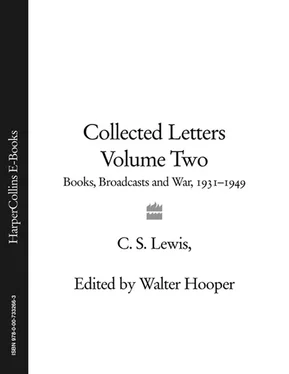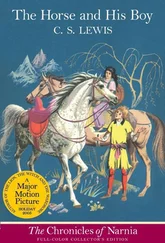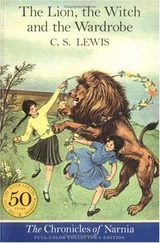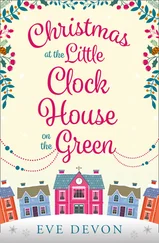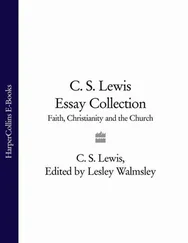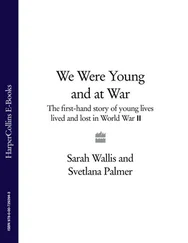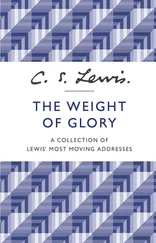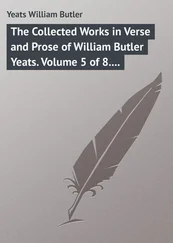THE COLLECTED LETTERS OF C. S. LEWIS
———VOLUME II——— Books, Broadcasts, and the War, 1931–1949 EDITED BY WALTER HOOPER

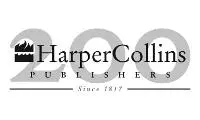
Copyright CONTENTS Cover Title Page Copyright Preface Abbreviations Letters: Chapter 1 - 1931 Chapter 2 - 1932 Chapter 3 - 1933 Chapter 4 - 1934 Chapter 5 - 1935 Chapter 6 - 1936 Chapter 7 - 1937 Chapter 8 - 1938 Chapter 9 - 1939 Chapter 10 - 1940 Chapter 11 - 1941 Chapter 12 - 1942 Chapter 13 - 1943 Chapter 14 - 1944 Chapter 15 - 1945 Chapter 16 - 1946 Chapter 17 - 1947 Chapter 18 - 1948 Chapter 19 - 1949 Keep Reading Biographical Appendix Index Books By C. S. Lewis About the Publisher
William Collins
An imprint of HarperCollins Publishers Ltd. 1 London Bridge Street London SE1 9GF
www.harpercollins.co.uk
THE COLLECTED LETTERS OF C. S. LEWIS, VOLUME II: Books, Broadcasts, and the War, 1931–1949. Copyright © 2004 by C. S. Lewis Pte Ltd.
The right of C. S. Lewis to be identified as the author of this work has been asserted by him in accordance with the Copyright, Designs and Patents Act 1988
A catalogue record for this book is available from the British Library
All rights reserved under International and Pan-American Copyright Conventions. By payment of the required fees, you have been granted the non-exclusive, non-transferable right to access and read the text of this ebook on-screen. No part of this text may be reproduced, transmitted, downloaded, decompiled, reverse engineered, or stored in or introduced into any information storage and retrieval system, in any form or by any means whether electronic or mechanical, now known or hereinafter invented, without the express written permission of HarperCollins ebooks
HarperCollins Publishers has made every reasonable effort to ensure that any picture content and written content in this ebook has been included or removed in accordance with the contractual and technological constraints in operation at the time of publication
Source ISBN: 9780006281467
Ebook Edition © JUNE 2009 ISBN: 9780007332663
Version: 2017-03-24
Cover
Title Page THE COLLECTED LETTERS OF C. S. LEWIS ———VOLUME II——— Books, Broadcasts, and the War, 1931–1949 EDITED BY WALTER HOOPER
Copyright
Preface
Abbreviations
Letters:
Chapter 1 - 1931
Chapter 2 - 1932
Chapter 3 - 1933
Chapter 4 - 1934
Chapter 5 - 1935
Chapter 6 - 1936
Chapter 7 - 1937
Chapter 8 - 1938
Chapter 9 - 1939
Chapter 10 - 1940
Chapter 11 - 1941
Chapter 12 - 1942
Chapter 13 - 1943
Chapter 14 - 1944
Chapter 15 - 1945
Chapter 16 - 1946
Chapter 17 - 1947
Chapter 18 - 1948
Chapter 19 - 1949
Keep Reading
Biographical Appendix
Index
Books By C. S. Lewis
About the Publisher
‘I have just passed on from believing in God to definitely believing in Christ—in Christianity.’ 1 C. S. Lewis had been an atheist for twenty years, and this was news his boyhood friend Arthur Greeves longed to hear. Arthur pressed him for details, and in the letter of 18 October 1931 with which Volume I of the Collected Letters of C. S. Lewis closed, Lewis described his momentous evening on 19 September when J. R. R. Tolkien and Hugo Dyson dined with him at Magdalen. They strolled through Addison’s Walk and then sat in Lewis’s rooms until 4 a.m. talking about Christianity and its relation to myth. ‘The story of Christ,’ Lewis concluded, ‘is simply a true myth : a myth working on us in the same way as the others, but with this tremendous difference that it really happened.’ 2
This second volume of letters begins at that point, and the reader soon discovers what a ‘tremendous difference’ conversion to Christianity made in Lewis. In the Family Letters Lewis was struggling to find his voice as a poet; in the letters included in this volume he had, it seems, found many voices. He writes on such a wide range of subjects that some readers will wonder if, perhaps, there was more than one C. S. Lewis.
Owen Barfield, 3 the intimate friend whose letters from Lewis run through all three volumes, suggested that there was indeed more than one Lewis. In a piece entitled ‘The Five C. S. Lewises’ Barfield wrote:
A fairly unsophisticated person who had never had any personal contract with Lewis, but who…had read the whole or most of what has been written about him, might be pardoned for wondering if it were not one writer, but three, with whom he was becoming acquainted: three men who just happened to have the same name and the same peculiar vigor of thought and utterance. Such a reader (I will venture to put myself in his shoes) might, to avoid confusion, adopt the nomenclature L1, L2, and L3, L1 being a distinguished and original literary critic, L2 a highly successful author of fiction, and L3 the writer and broadcaster of popular Christian apologetics. 4
Barfield went on to point out that one of the first things the ‘unsophisticated person’ would notice is that, while admirers of Lewis the Original Literary Critic usually have little interest in the Lewis the Christian Apologist, readers of both Lewis the Original Literary Critic and Lewis the Christian Apologist are interested in Lewis the Writer of Fiction. Another thing such a person would notice, said Barfield, is that Lewis the Original Literary Critic has received much less attention than the other two Lewises, and that it would hardly be too much to say that the Literary Critic has been ‘swamped’ by the Apologist and the Writer of Fiction.
The other two Lewises mentioned by Owen Barfield are ‘the one before and the other after his conversion’. 5 Given that Lewis was now a Christian, how were these four remaining Lewises related? Again I turn to Owen Barfield who knew them longer and probably thought more about them than anyone:
The unity of all these Lewises is to my feeling as impressive, or even more impressive, than their diversity. Others, of course, have drawn attention to it, but I am not sure that anyone has succeeded in locating it. Some have pointed to his ‘style,’ but it goes deeper than that. ‘Consistency?’ Noticeable enough in spite of an occasional inconsistency here or there. His unswerving ‘sincerity’ then? That comes much nearer, but still does not satisfy me. Many other writers are sincere—but they are not Lewis. No. There was something in the whole quality and structure of his thinking, something for which the best label I can find is ‘presence of mind.’ If I were asked to expand on that, I could say only that somehow what he thought about everything was secretly present in what he said about anything. 6
While all but the last three letters in Volume I were written by the unconverted Lewis, those in Volume II were written by the convert.
As it turns out, the neglected Original Literary Critic is the first C. S. Lewis to appear in this volume. Lewis would have considered it unconscionable to use his tutorials, lectures and letters as a pulpit for his Christian beliefs, but his conversion to the Faith certainly made a difference, not least to the book he began writing in 1928 and which was published in 1936 as The Allegory of Love: A Study of Medieval Tradition. ‘A believed idea,’ he said, ‘ feels different from an idea that is not believed.’ 7 Or, as he observed in 29 January 1941 to Mary Neylan, once his pupil, ‘One of the minor rewards of conversion is to be able to see at last the real point of all the old literature which we are brought up to read with the point left out!’ 8
Читать дальше
